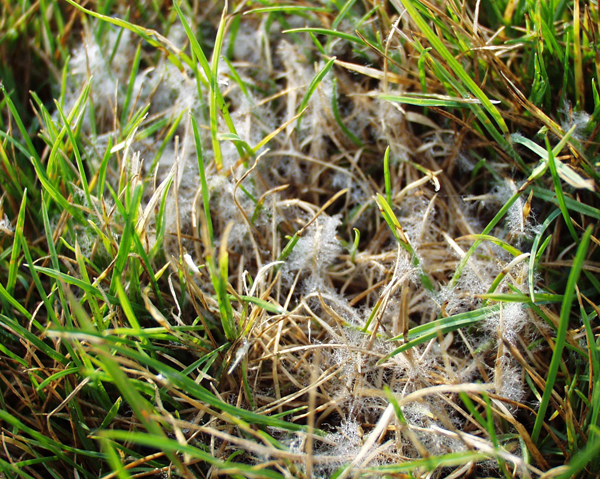|
Dollar spot is caused by a fungal pathogen, Sclerotinia homoeocarpa, that blights leaf tissues but does not affect turfgrass roots or crowns. The disease is a common concern on golf course turf, especially creeping bentgrass and annual bluegrass greens, tees, and fairways, where it can result in poor turf quality and appearance. Dollar spot is one of the most readily identifiable diseases on golf course turf. Characteristic symptoms on creeping bentgrass include small—up to 1 inch in diameter—round, tan-colored spots. The spots often occur in clusters and can cause considerable damage to playing surfaces if not appropriately managed. In the early morning hours after a long dew period, the dollar spot pathogen will produce an abundance of mycelia on affected plant parts. Characteristic symptoms on individual plants include distinct lesions with straw-colored centers and reddish-brown margins on leaf blades. Leaf spot symptoms are more readily observed on taller mown turf species such as Kentucky bluegrass and perennial ryegrass. The dollar spot pathogen survives in the turf environment as mycelium in infested turf debris. The pathogen becomes active with rising temperatures in the spring. Mycelial growth and infection occur during extended dew periods (longer than 8 hours) over a broad range of temperatures (55˚-80˚F). Dollar spot outbreaks usually are more severe in nitrogen deficient turf stands. Turf suffering from poor nutrition also is slow to recover from disease damage. The pathogen produces no spores: spread occurs through radial growth from individual infection centers. S. homoeocarpa inhabits most soils so spread by golfers and equipment is not especially important. |
 |
Dollar Spot Control
Non-chemical options—genetic, cultural, and biological—can be exploited to reduce disease pressure, thereby improving fungicide performance. They also are part of a comprehensive resistance management strategy—limiting pathogen population growth and reducing opportunities for mutation to fungicide resistance. All modern creeping bentgrass cultivars are susceptible to dollar spot, but there are significant differences in their susceptibility. Cultivar evaluations are published by the National Turfgrass Evaluation Program and usually by universities with turf science programs. Although cultivars are selected based on their agronomic qualities, susceptibility to disease should not be overlooked. Because dollar spot is more severe on nitrogen-deficient turf, an adequate nitrogen fertility program will significantly contribute to disease control. Adequate nitrogen nutrition will produce plants that are less prone to disease. The result will be a delay in disease outbreaks in the spring, reduced severity of outbreaks, improved fungicide performance, and more rapid turf recovery. Proper irrigation scheduling also may contribute to dollar spot control. Since the duration of the dew period is proportional to the extent of infection, any irrigation practice that prolongs the dew period will contribute to serious disease outbreaks. Nighttime and early morning irrigation are preferred. Irrigation during the late afternoon and early evening hours should be avoided.
There are a number of biological control applications that reportedly contribute to reducing dollar spot severity. Some professional turf managers have had success with various biological control applications while others have experienced disappointment.
The mixed results should not be unexpected because the microbiology of the turfgrass environment is extremely complex. It is likely that all factors contributing to turfgrass growth and development influence the efficacy of biological control applications. Consequently, the extent to which biological applications contribute to disease control may be determined only after on-site experimentation by individual turf managers.
Various fungicides registered for use on turfgrass perform well against dollar spot. Because dollar spot infection occurs over almost the entire growing season, other disease threats should be considered when selecting a fungicide for dollar spot control. For the same reason, dollar spot should always be considered when selecting fungicides targeting certain other diseases such as anthracnose, brown patch, necrotic ring spot, summer patch, and take all patch. Scheduling applications will influence fungicide performance. The best approach is to anticipate outbreaks and schedule applications of effective fungicides before symptoms are apparent. Fungicides perform well in such cases because the pathogen component of disease pressure, that is the extent of outbreak, is low. Furthermore, applying fungicides to reduced pathogen populations will reduce the risk of fungicide resistance.